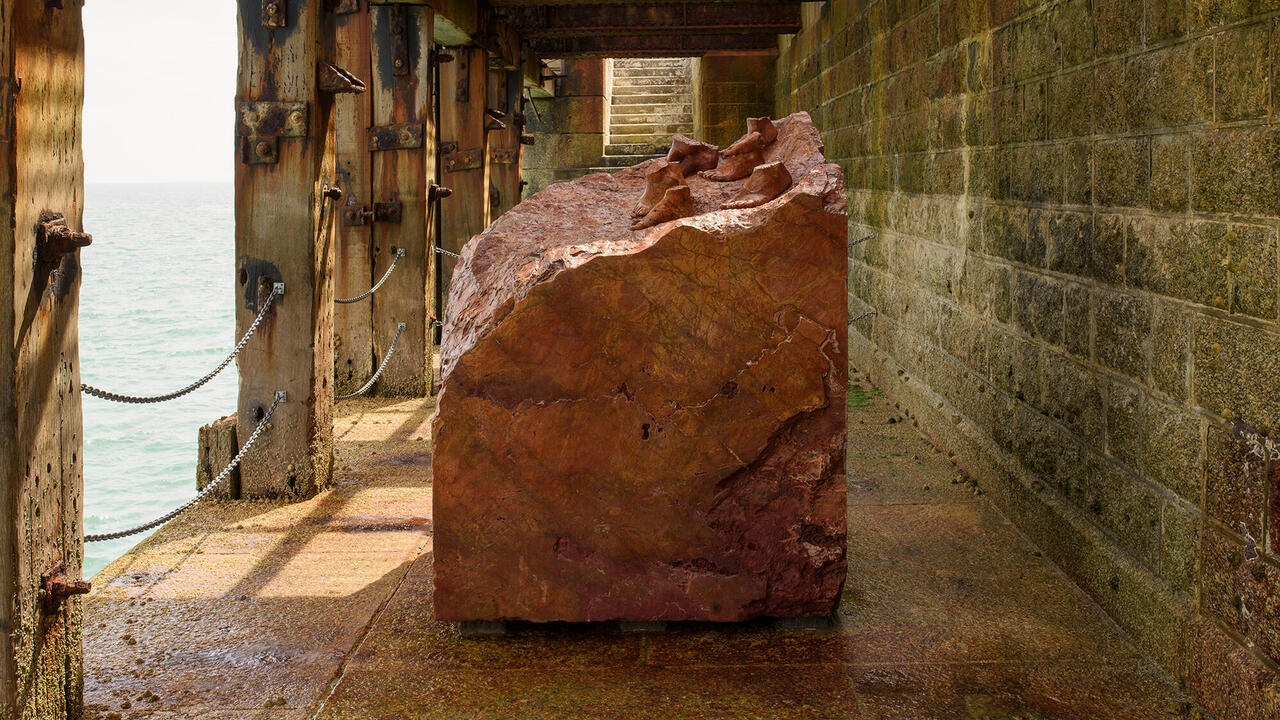Cathy de Monchaux
First of all, you're beguiled into letting your senses off the leash. It's impossible not to be sucked in to the intricatte bolting, folding, overlapping, latticing and tying of Caty de Monchaux's latest wall pieces; and there's no defence against becoming ensnared by the obsessive details of their manufacture. De Monchaux has always manipulated the tension between opposites: attractive/repulsive, hard/soft, functional/luxurious, but now she's honed and refined these unholy alliances and put them to work in a new context of opulence and adornment.
De Monchaux has moved into the pleasure zone. The chunky brass sections and buckled leather straps which encircle and bite into the ruched red velvet centre of the earliest works on show, Defying Death, I Ran Away to the Fucking Circus 1991, have mutated into the outrageously ornamental brass rosettes of Holding Back From Nothing and Scarring the Wounds (both 1993) which bristle with baroque spikes and curlicues and hang flat against the wall, threaded with ribbons and seeping velvet from between their metal plates. There's the sly suggestion of sexual stereotypes, as disciplined metallic precision curbs and suppresses sumptuous fabric, but the savage beauty of these most recent tortuous confections, together with their melodramatic whole-hog titles, indicates that she has seriously upped the ante.
Four years ago de Monchaux wanted her work to form a relationship with the viewer 'of consummatable flirtation and desire'; and now she pushes this courtship further. From subverting the no nonsense language of utilitarian objects with her sly slivers of fabric, she now makes pieces which are ostentatiously designed to seduce. Like good sex, the best of the work in this show is playful, occasionally comical, and flirts with danger. You don't notice when it hurts and when you do, it just makes it better.
But de Monchaux is too smart to allow her work to be understood as a sexual equivalent. The very exquisiteness which acted as the initial pull is also a decoy that is designed to add to the ambiguity. In the past she has tried to complicate her sculpture's fetishistic associations by playing down details and smothering bolts of fabric beneath slabs of plain marble. Now she has become more wily, and instead destablises notions of domination and vulnerability by appearing to collude with and dress up for the enemy. In the statement accompanying the show, she speaks of her overriding feeling as a woman in the 90s as being one of fear; and, like a scorpion fish flashing its fins, she takes up beauty as both a bait and a defence. 'Women are not developed to protect themselves against the male predator, no teeth, no claws, no speed, no camouflage, no strength.'
The strongest work in the show is also the smallest - three tiny pieces jut provocatively from the walls like sprung, jewelled traps, baring their soft innards and daring you to face the consequences of contact. But just when you think that you've located the strategy behind their concealing and revealing, you look at their titles -Once Upon a Fuck; Belonging to a Subspecies That is Yet to be Named; Conditional Losses - and realise that you've been rumbled. De Monchaux is all too pre-emptively aware of the hazards facing artists who attempt to work in the gap between Freud and Feminism - she has come a long way from the time when she stated that it was impossible to work from a woman's perspective in a world that was dominated by the male point of view. Once Upon a Duchamp (1992), with its scrolls of white paper lined with fleshy red plush and pinned to the wall by elegantly clawed brass clamps, shows that she can reappropriate with the best of them.
Once ipon a time, when questioned too closely about the erotic content of her work, the painter and soft sculptor Dorothea Tanning responded with the throwaway explanation that 'all is libido, nicely smothered.' Cathy de Monchaux has also learned the power of play, and she presents miniature monuments to an alternative world built on uncertainty rather than absolutes, where size and muscle have no currency, and where identity is neither static nor sovereign.
















